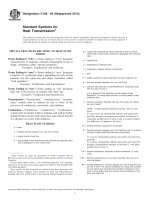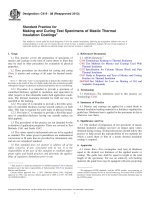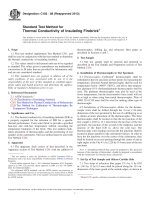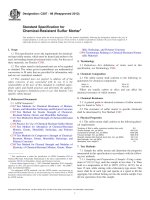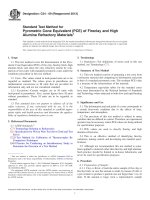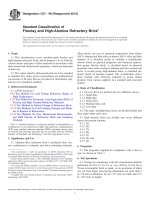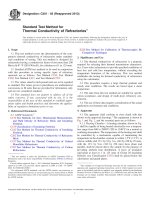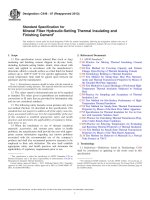Astm c 27 98 (2013)
Bạn đang xem bản rút gọn của tài liệu. Xem và tải ngay bản đầy đủ của tài liệu tại đây (59.69 KB, 2 trang )
Designation: C27 − 98 (Reapproved 2013)
Standard Classification of
Fireclay and High-Alumina Refractory Brick1
This standard is issued under the fixed designation C27; the number immediately following the designation indicates the year of original
adoption or, in the case of revision, the year of last revision. A number in parentheses indicates the year of last reapproval. A superscript
epsilon (´) indicates an editorial change since the last revision or reapproval.
This standard has been approved for use by agencies of the Department of Defense.
These bricks can vary in chemical composition from almost
100 % alumina and little silica to almost 100 % silica and little
alumina. It is therefore useful to establish a classification
scheme based on physical properties and chemical analysis.
One group, fireclay brick, is classified based on physical
properties since some overlap of alumina and silica content can
occur. A second group, high-alumina brick, is classified primarily based on alumina content. The classification allows
those familiar with refractory materials to group similar
products from various suppliers in a standard and consistent
manner.
1. Scope
1.1 This classification covers machine-made fireclay and
high-alumina refractory brick, and its purpose is to set forth the
various classes and types of these materials in accordance with
their normal and characteristic properties, which are important
in their use.
1.2 The values stated in inch-pound units are to be regarded
as standard. The values given in parentheses are mathematical
conversions to SI units that are provided for information only
and are not considered standard.
2. Referenced Documents
4. Basis of Classification
2.1 ASTM Standards:2
C16 Test Method for Load Testing Refractory Shapes at
High Temperatures
C24 Test Method for Pyrometric Cone Equivalent (PCE) of
Fireclay and High Alumina Refractory Materials
C113 Test Method for Reheat Change of Refractory Brick
C133 Test Methods for Cold Crushing Strength and Modulus of Rupture of Refractories
C134 Test Methods for Size, Dimensional Measurements,
and Bulk Density of Refractory Brick and Insulating
Firebrick
4.1 Fireclay Brick are divided into five different classes:
4.1.1 Super-duty,
4.1.2 High-duty,
4.1.3 Semi-silica,
4.1.4 Medium-duty, and
4.1.5 Low-duty.
4.2 The super- and high-duty classes are divided further into
three types under each class.
4.3 High-Alumina Brick are divided into seven different
classes by percent alumina:
4.3.1 50,
4.3.2 60,
4.3.3 70,
4.3.4 80,
4.3.5 85,
4.3.6 90, and
4.3.7 99.
NOTE 1—Chemical analysis of refractory products is determined by a
combination of x-ray fluorescence (XRF) and inductively coupled plasma
(ICP) using standard reference materials (SRM), including various types
of minerals and refractory materials that are available from the National
Institute of Standards and Technology3 and other appropriate sources.
3. Significance and Use
3.1 Alumina-silica refractory brick is produced from various combinations of alumina and silica-containing materials.
5. Properties
5.1 The properties required for compliance with a class or
type are shown in Table 1.
1
This classification is under the jurisdiction of ASTM Committee C08 on
Refractories and is the direct responsibility of Subcommittee C08.92 on The Joseph
E. Kopanda Subcommittee for Editorial, Terminology and Classification.
Current edition approved Sept. 1, 2013. Published September 2013. Originally
approved in 1958. Last previous edition approved in 2008 as C27 – 98 (2008). DOI:
10.1520/C0027-98R13.
2
For referenced ASTM standards, visit the ASTM website, www.astm.org, or
contact ASTM Customer Service at For Annual Book of ASTM
Standards volume information, refer to the standard’s Document Summary page on
the ASTM website.
3
Available from the National Institute of Standards and Technology (NIST),
Gaithersburg, MD 20899.
6. Test Specimens
6.1 Testing for compliance with this classification shall be
performed on 9 by 41⁄2 by 21⁄2 or 3-in. (228 by 114 by 64 or
76-mm) rectangular brick as made, or on specimens of either
size cut from larger units having dimensions not more than 3
in. (76 mm) in thickness, 63⁄4 in. (171 mm) in width, and 131⁄2
in. (342 mm) in length.
Copyright © ASTM International, 100 Barr Harbor Drive, PO Box C700, West Conshohocken, PA 19428-2959. United States
1
C27 − 98 (2013)
TABLE 1 Fireclay and High Alumina Refractory Brick Classified According to Classes and Subdivided into Types
Class
Type
Fireclay Brick:
Super-duty
High-duty
Semi-silica
Medium-duty
Low-duty
High-Alumina Brick:
Alumina, %:
50
60
70
80
85
90
99
PCE, min
Hot Load
Subsidence, max, %
Reheat Shrinkage,
max, %
Modulus of
Rupture, min, psi
(MPa)
Other Test Requirements
Regular
33
...
1.0 at 2910°F
600 (4.14)
...
Spall-resistant
33
...
(1600°C)
1.0 at 2910°F
600 (4.14)
...
Slag-resistant
33
...
(1600°C)
...
1000 (6.89)
Regular
Spall-resistant
Slag-resistant
311⁄2
311⁄2
311⁄2
...
...
...
...
...
...
...
500 (3.45)
1200 (8.27)
...
1.5 at 2460°F
...
300 (2.07)
Bulk density, min, 140 lb/ft 3
(2.24 g/cm3)
...
...
Bulk density, min, 137 lb/ft 3
(2.19 g/cm 3) or porosity,
max, 15 %
Silica (SiO2) content, min, 72 %
29
15
(1350°C)
...
...
...
...
500 (3.45)
600 (4.14)
34
35
36
37
...
...
...
...
...
...
...
...
...
...
...
...
...
...
...
...
...
...
...
...
...
...
...
...
...
...
Alumina (Al2O3) content, %:
50 ± 2.5
60 ± 2.5
70 ± 2.5
80 ± 2.5
85 ± 2.0
90 ± 2.0
min, 97
7. Test Methods
8. Retests
7.1 The properties enumerated in this classification shall be
determined in accordance with the following ASTM test
methods:
7.1.1 Pyrometric Cone Equivalent (PCE)— Test Method
C24.
7.1.2 Reheat Test for Super-Duty Brick (2910°F, 1600°C)—
Schedule C of Test Method C113.
7.1.3 Load Test (2460°F, 1350°C) —Schedule No. 2 of
Method C16.
7.1.4 Modulus of Rupture—Test Methods C133.
7.1.5 Bulk Density—Test Methods C134.
7.1.6 Silica and Alumina Contents—XRF and ICP.
8.1 If variables result from sampling or a lack of satisfactory
reproducibility in tests conducted by different laboratories, the
material shall be resampled and retested when requested by
either the manufacturer or the purchaser. This is applicable in
instances when the first test results do not conform to the
requirements prescribed in this classification. The final results
to be used shall be the average of at least two sets of results,
each of which has been obtained by following in detail the
specified testing procedures.
9. Keywords
9.1 fireclay brick; high-alumina brick; properties
ASTM International takes no position respecting the validity of any patent rights asserted in connection with any item mentioned
in this standard. Users of this standard are expressly advised that determination of the validity of any such patent rights, and the risk
of infringement of such rights, are entirely their own responsibility.
This standard is subject to revision at any time by the responsible technical committee and must be reviewed every five years and
if not revised, either reapproved or withdrawn. Your comments are invited either for revision of this standard or for additional standards
and should be addressed to ASTM International Headquarters. Your comments will receive careful consideration at a meeting of the
responsible technical committee, which you may attend. If you feel that your comments have not received a fair hearing you should
make your views known to the ASTM Committee on Standards, at the address shown below.
This standard is copyrighted by ASTM International, 100 Barr Harbor Drive, PO Box C700, West Conshohocken, PA 19428-2959,
United States. Individual reprints (single or multiple copies) of this standard may be obtained by contacting ASTM at the above
address or at 610-832-9585 (phone), 610-832-9555 (fax), or (e-mail); or through the ASTM website
(www.astm.org). Permission rights to photocopy the standard may also be secured from the ASTM website (www.astm.org/
COPYRIGHT/).
2
